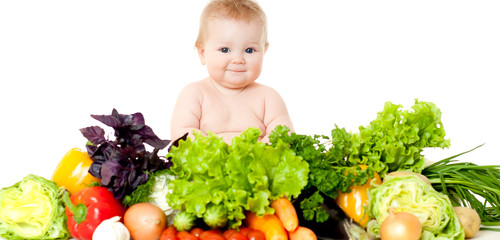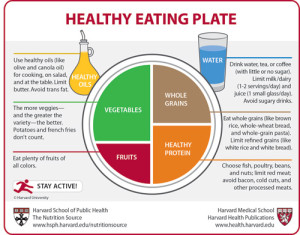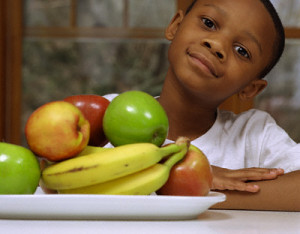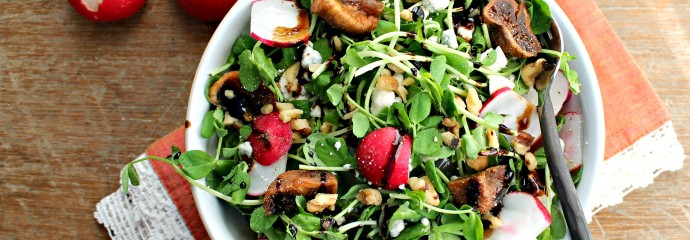
Healthy Portion Sizes for Children
Posted July 29, 2015 | UncategorizedIntroduction
Proper nutrition is important for children in order to thrive and grow. To make sure they get the proper nutrients it is important for children to eat a well-balanced diet. When determining what your child needs it is important to take into consideration their age, activity level, gender, and any specific dietary recommendations provided by a dietitian or doctor.
Below is a table that breaks down servings for each food group based on age- (note: these are suggestions for neurotypical healthy developing children and may not be appropriate for medically prescribed diets). 
A great tool to use when planning out meals for your child is the My Plate developed by Harvard University. The plate serves as a great base for making balanced meals and it can be adjusted based on individual needs and diets.
Food Groups
How much food your child needs is important, but the type and quality of food is just as essential. For example, items like pasta, bagels, and bread are all refined sources of grain. It best to select whole grains such as rice, quinoa, buckwheat, etc. over refined grains to help control blood sugar and optimize nutritional value. If your child is gluten free, choose high quality gluten free options for the above mentioned foods.
When it comes to vegetables, variety is key in color and type. While potatoes are a vegetable, they act similar to grains in the body (turn to sugar) and should not count as a daily vegetable. Experiment with different vegetables to make your plate  colorful. See our previous seasonal blog posts here and here for some ideas.
colorful. See our previous seasonal blog posts here and here for some ideas.
Whole fruits are preferred over fruit juice to reach the required servings. Similar to vegetables, variety is important and dark colorful fruit such as berries are packed with antioxidants.
Protein can come from a variety of sources like beans, nuts, meat, poultry, fish, eggs, tofu and tempeh. Dairy, although not included on the Harvard My Plate, can be a source of protein and other nutrients required for growth, especially for active children. When picking dairy products look for full fat or reduced fat options for milk, yogurt or cheese since non-fat dairy is missing key nutrients and can negatively affect blood sugar. If your child is dairy-free, there are alternative options available in most grocery stores.
Finally fat sources should focus on quality. Select mono or polyunsaturated fats like nuts, seeds, olive oil, and avocado.
Division of Responsibility
Making sure your child is eating enough is an important responsibility, but this does not mean you have to meticulously measure food unless directed to by a professional. Ellyn Satter has done research on proper ways to feed children and developed what she calls the division of responsibility around eating. The parent is in charge of when, where, what is eaten, but the child determines how much and whether they eat. The parents prepare balanced meals and snacks, makes eating time pleasant, and models proper meal time behavior. The child eats based on what they need, learns to eat foods prepared by parents, and learns to behave well at the table. By combing Ellyn Satters principles with developing well-balanced meals, you can provide your child with all the tools they need to grow and mature properly. This approach works for many families though may not be appropriate for all.
Healthy Portion Sizes by Age: Typical Diet (50% Carb, 20% Protein, 30% Fat)
Food Group
|
Servings Per Day |
Portion Size 1-3 yrs.
|
Portion Size 4-8 yrs.
|
Portion Size 9-13
|
Grains
|
Age1-3: 4 svg/day4-8: 4 svg/day9-13: 5-6 svg/ day
|
½ cup whole grain pasta or rice1/4 cup potatoes or beans1/2 slice of whole wheat bread1/2 cup cold cereal1/3 cup of oats uncooked
|
½ cup whole grain pasta or rice½ cup potatoes or beans1 slice of whole wheat bread¾ cup cold cereal1/3 cup of oats uncooked1 six-inch corn/whole wheat tortilla
|
½ cup whole grain pasta or rice½ cup potatoes or beans1 slice of whole wheat bread¾ cup cold cereal1/2 cup of oats uncooked1 six-inch corn/whole wheat tortilla
|
Vegetables
|
2-3 servings
|
½ cup – 1 cup of fresh or frozen vegetables¼ cup of cooked vegetables
|
½ cup – 1 cup of fresh or frozen vegetables½ cup of cooked vegetables½ cup of salad
|
½ cup – 1 cup of fresh or frozen vegetables½ cup of cooked vegetables½ cup of salad
|
Fruit
|
2-3 servings
|
¼ cup cooked, frozen or canned½ piece fresh¼ cup of 100% juice
|
¼ cup cooked, frozen or canned½ piece fresh1/3 cup of 100% juice
|
1/3 cup cooked, frozen or canned1 piece½ cup 100% juice
|
Protein
|
2-3 servings
|
1 oz. meat, fish, chicken, or tofu¼ cup cooked beans½ egg
|
1 oz. meat, fish, chicken, or tofu½ cup cooked beans1 egg
|
1 oz meat, fish, chicken, or tofu½ cup cooked beans1-2 egg
|
Dairy
|
2-3 servings
|
1/2 cup of milk½ ounce of cheese1/3 cup yogurt
|
½ cup of milk1 ounce of cheese½ cup yogurt
|
1 cup of milk1 ounce of cheese¾ cup yogurt
|
Fats |
1 serving |
1 Tablespoon of avocado, nuts or nut/seed butter, olive oil, coconut oil |
1 Tablespoon of avocado, nuts or nut/seed butter, olive oil, coconut oil |
1 Tablespoon of avocado, nuts or nut/seed butter, olive oil, coconut oil |

Inspiring Spring Produce
Posted April 21, 2015 | Nutrition & Health Tips, recipes, UncategorizedSpring has finally arrived! The tulips are in bloom, the sun is starting to shine, and the wonderful smells of spring are filling the air. A new season means new seasonal produce options and the opening of farmers markets. Snap yourself out of the winter blues by changing up some of your meals to incorporate more fresh spring produce. This spring produce guide will provide you with new recipes to freshen up your meals and kick start spring! To look for a farmers market in your area visit: http://seattlefarmersmarkets.org/
Artichokes: The edible bud of the thistle flower that have an earthy flavor and meaty texture. Simply steaming the artichoke and adding a squeeze of lemon or a drizzle of butter are easy preparations. The hearts of the artichoke can be chopped and added to salads and pastas. Here are some tips on how to trim and prepare artichokes for cooking. Artichokes have several health benefits that many people are not aware of. They are loaded with antioxidants and phytochemicals that can help with digestion, cholesterol, liver function, and cancer prevention. Artichokes are ranked in the top four for antioxidant containing vegetables and ranked seventh highest overall. While the hearts are the most popular part, the leaves contain the most beneficial nutrients.
Asparagus: They come in three colors green, purple and white. Asparagus can be used pureed in a creamy soups, boiled or steamed and tossed with a light vinaigrette to make a salad, or chopped and baked into frittatas. Learn how to prepare and store them here. Asparagus are a great source of fiber, folate, and vitamins A, C, E, K. The chromium in asparagus helps increase the transport of glucose from the blood stream into the cells by insulin. Glutathione is also abundant and is an important detoxifying compound that protects our bodies against dangerous reactive oxygen species. Besides glutathione there are several other important antioxidants found in asparagus.
Radishes: a root vegetable that has a sweet peppery taste and can be red, white, purple or black. Slice the radishes thinly and add them into salads for a flavor punch. Also simply sauté them with some lemon and butter as a side dish. Experiment with radishes with these recipes. Radishes might not be on the top of the list of your favorite vegetables, but here are some reasons why you should add them to your grocery basket. They are naturally cooling and their pungent flavor is used in eastern medicine to cool the body during the hot summer months. Next time you have a sore throat try sucking on a radish. The pungent flavor and natural spice helps eliminate excess mucus, sooth soar throats, and clear sinuses. Radishes are also a natural cleansing agent for the digestive tract and eliminate stagnant foods and toxins that have built up over time. Their high vitamin C content can help keep you healthy providing antioxidants to help fight off infections.
Strawberries: Their vibrant red color shouts springtime! They are also full of antioxidants and anti-inflammatory compounds. Add them in your morning cereal, oatmeal or granola. Chop and freeze them to make refreshing afternoon smoothies. Make a sweet dessert with angle food cake topped with fresh strawberries, or chop them up and add them into your salad. There are endless possibilities for this juicy fruit have fun experimenting! Strawberries provide vitamin C that works as an antioxidant to boost your immunity. Other benefits of their antioxidant properties are the prevention of cataracts, maintenances of healthy skin, and cancer fighting abilities. They also contain phytochemicals like flavonoids. These are good for fighting heart disease by providing protection against oxidative damage and inflammation. Their anti-inflammatory effect can also be beneficial to people who have arthritis. Strawberries also contain about 135 mg of potassium per serving that can help with the regulation of blood pressure. Besides heart health they are also modest benefits for digestion due to the fiber content with 2g per serving.
Pineapple: Take your taste buds on a tropical retreat with this juicy fruit in smoothies, salads, or just simply eaten on its own. Make your traditional salsa more exciting by adding some pineapple. There is nothing like biting into a nice juicy piece of pineapple on a warm spring day. Here are some great ideas! One cup of fresh pineapple provides 131% of vitamin C needs for the day, 2% of vitamin A, 2% of calcium, and 2% of iron. Bromelain, an enzyme found in pineapples, can reduce swelling, bruising, healing time, and pain associated with injury and surgery. The fiber potassium and vitamin C found in pineapples are beneficial for heart health, and blood pressure. Pineapple is also good for energy because it contain vitamins like thiamin, and riboflavin.
Spring Produce List:
- Artichokes
- Asparagus
- Broccoli
- Butter lettuce
- Cabbage
- Carrots
- Celery
- Collard Greens
- Fava Beans
- Fennel
- Green Beans
- Garlic
- Greens
- Lettuce
- Mango
- Mushrooms
- Mustard Greens
- Peas
- Pineapple
- Radicchio
- Ramps
- Radhish
- Snow peas
- Spinach
- Strawberries
- Turnips
- Watercress
Menu Ideas:
One Week of Healthy Spring Dinners
Spring Meal Ideas- Breakfast, Lunch, Dinner
Sources:
http://www.medicalnewstoday.com/articles/276903.php
http://www.whfoods.com/foodstoc.php
http://www.fruitsandveggiesmorematters.org/whats-in-season-spring








